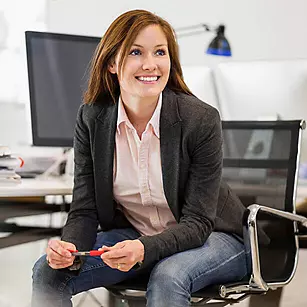Here's the inspiring story of how one dad turned his love of design and his kids' enthusiasm for creativity into a family business.
For 14 years, digital designer Jon Alexander successfully freelanced from his home in Madeira, Ohio, allowing him to work in close quarters with his young daughters, Kalley (7) and Corbett (8). But in 2012, Jon got a full-time job offer he couldn't pass up.
"I had a great opportunity to work with three of the most talented guys I know at a startup for one of the most successful creative businessmen I have ever known," Jon says. "It was a salary, a percentage of ownership and a chance to make something great with people I loved."
When Jon and his wife Carrie told the kids he got a new job and would be gone all day, they also explained the new role would allow Jon to make money to buy food and other things the family needed. Kalley, who was four at the time, understood the situation but wasn't ready to accept it.
The Alexanders are a creative bunch. Jon is the professional designer; Carrie is quite crafty herself. Corbett sketches animals with sparkly eyes and writes songs about Silly Putty. Kalley loves unicorns and solving problems. The new-job announcement led Kalley to draw a machine that would make food so the family wouldn't need money and Jon could stay home.
All Jon had to do was build it.
Jon explained to Kalley that even if he could build it, the machine probably wouldn't work. But Kalley's determination to find a way for her family to spend more time together played into an ongoing conversation Jon and Carrie had been having. They'd been talking about adapting their lifestyle to better fit the things they truly cared about. "As a freelancer, life was always flexible," Jon says. "So it wasn't hard to imagine something different that put a premium on creating things together."
Having vision
Even though Jon couldn't build the machine with a hammer and nails, he realized he could construct it with digital tools. Kalley's drawing had a lot of clever mechanical features – cranks, dials, levers, buttons, boilers, bashers, puffers, shrinkers, bakers, painters, pickers – that could become fun interactive elements in a story the family could build as an app.
That app could then be sold for money, which they could use to buy food so Jon wouldn't have to go away to work anymore. Still, the opportunity at the startup was too good to pass up, so Jon made the commute.
But Jon just couldn't let go of the idea of creating something so meaningful with his wife and kids. So, in his spare time, he worked on the app about Kalley's machine, incorporating the entire family's talents.
"Kalley's Machine Plus Cats" ($2.99) launched last week and immediately generated buzz. Apple is currently promoting it on the App Store homepage. The app itself is an interactive children's story about how Kalley came up with the idea for the machine and how it works. Jon and Kalley narrate the story with highlighted words so kids can follow along, and there's also a touch-to-read feature that speaks the words as kids tap them. More than 60 touchable controls put children in charge of each twist and smash of the machine.
Although the app has a lot of fun, educational features, the Alexanders are most proud of the fact they made it together, creating original art, animation, sound effects and music. And they hope to make more collaborative stories, characters and games for families through their new company, RocketWagon.
"One idea I'm leaning toward is a game about a street kid in Brazil," Jon says. "It features a homeless boy as the protagonist. You try to help him improve his soccer skills in hopes of escaping poverty. We want our kids to learn about global poverty and to be a part of the solution. A portion of our proceeds would benefit organizations that work with street children."
The Alexanders have also considered creating a series of interactive stories that tour famous parts of the world and apps that put kids in the seat of parents – like a game where players attempt to get two kitties to finish dinner in a set amount of time.
Developing skills
While it's important to Jon and Carrie that their apps will be educational for their customers, they also want their kids to learn about storytelling as they share in the creation of the products. "The stories we hear frame the way we view our own narrative," Jon says. "Just look at how the princess narrative has influenced the women of our world, for better and worse. So we spend time reflecting on movies we watch and stories we read, talking about what made them good and what would have made them better."
 |
| Making "Kalley's Machine Plus Cats" was a group effort. Jon Alexander and his family created the interactive story, featuring original art, animation, sound effects and music. |
The family is also working on developing their drawing skills, using Adobe Ideas on the iPad to get their sketches from paper to digital. Soon, they'll add in other Adobe products like Premiere, After Effects and Photoshop. Eventually, Jon hopes to teach Kalley and Corbett animation using 2-in-1 tablets that can run Flash. "It's amazing when you think of how kids could easily learn to draw in four dimensions when they are usually limited to two," Jon says. "Touchscreen computers have made animation really accessible for kids."
Teaching creativity and perseverance
Creativity is a hallmark of the Alexander family and the RocketWagon operation. "We want our kids to see that they can create world-class stuff. I want them to be fearless in this," Jon says. "We also want them to see what it takes to achieve that level of quality. When Kalley and I are doing our fifth round of voiceover takes, it's really exhausting, but the results are worth it."
Jon and Carrie want their kids to have professional-grade visual and verbal communication skills before they graduate high school. "These skills are critical in the information age, and I'm fortunate enough to be able to teach them some of that stuff," Jon adds. "It's like our family trade."
Learning lessons on fatherhood
Of course, not all of this comes easily, and Jon says the hardest part for him is being a good leader. Leadership, he admits, does not come naturally. "But the one place I shine is as a creative lead," Jon says. "I remember my wife being awed when she saw me direct a video shoot. It may have been the first time she had ever seen me act with absolute confidence."
So, positioning his family as a creative team helps him better understand his role as a father, although it's still challenging. "My wife and kids have talent, but it has been really hard for me to help them develop this talent. I am used to working with professionals who meet deadlines, don't make excuses and work independently. This is the opposite of that," he says with a laugh.
But he's been amazed by how many general business leadership principles transfer over to family leadership. "My friend from the startup warned me above all else that, in business culture, you must over-communicate. 'You think everybody is on the same page, but they are not,' he said. 'So you have to come back to the vision over and over again.' He was not wrong – about business or family," Jon says.
Putting a premium on relationships
In the fall of 2012, Jon's friend who had founded and funded the startup he worked for suddenly passed away. The startup was done. "It was one of those moments in life where everything that doesn't really matter fades into the background," Jon says. "Relationships are what really count. At that moment, I knew I had to try to work with my wife and kids."
Fortunately, Jon's old clients were ready for him to freelance again, so now he splits his time between freelance work and RocketWagon. Jon says he'll keep freelancing as long as necessary but hopes that RocketWagon eventually swallows his career plans.
"I've only realized recently how all my best relationships are with people I collaborate with. Sometimes the collaboration isn't professional – it can be just kicking around our latest ideas," Jon says. "But I love building things with creative people. It's why I love my long-time client relationships. We've crafted brilliant pitches together, braved impossible deadlines, pulled all-nighters, held off scope creep. And those experiences have forged a deep loyalty. I want that with my wife and kids."








